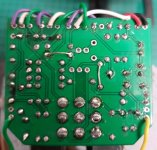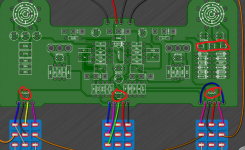jinx_defusing
New member
Hey everyone,
I'm a bit rough with my pcbs. And this roughness is totally unwarranted. Every step of the way should be done with light touch, so I'm trying to pull back the reins. Go slow. Be gentle. Use only as much solder and heat as is needed. So on and so forth.
Anyways, I have some questions about damaged PCBS:
I'm a bit rough with my pcbs. And this roughness is totally unwarranted. Every step of the way should be done with light touch, so I'm trying to pull back the reins. Go slow. Be gentle. Use only as much solder and heat as is needed. So on and so forth.
Anyways, I have some questions about damaged PCBS:
What do you all do when you have damaged or completely destroyed a contact point (not sure if this is proper terminology. I mean the little metal circles that you solder the leads to)?
- What if the contact point is only damaged on one side?
- both sides?
- I use a copper wick to de-solder, but using this is what most often leads to damaged contact points. Are solder suckers safer to use? I can't seem to make them work well for me.
When you scratch the surface of the PCB and reveal the copper that was beneath the surface, how concerning is this?
- I'm concerned that the scratch can act sort of like a jumper between any conncections that come into contact with the exposed copper. However, copper is an insulator, right? So is it right to assume that the current will not travel across the scratch/exposed copper?
- If this is a problem, what can be done about it? Is there a way to cover the exposed copper?
Sometimes, my iron will come into contact with components that are already soldered on to the PCB. Capacitors, usually. This happens mostly with polypropylene film box caps. It's easy to melt off a small bit of the capacitor's outer layer.
- If I just barely nicked the edge/ coroner, can I still use this component? Or is it fried at that point? Can I determine that by using a multi-meter?





